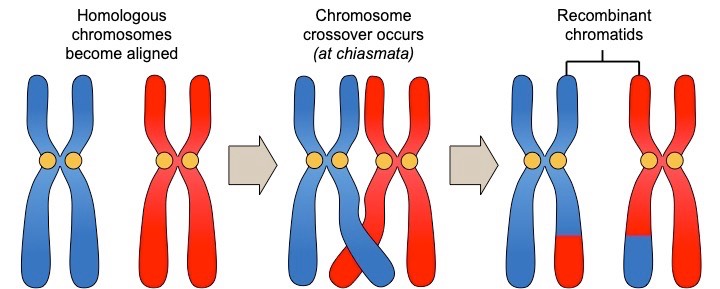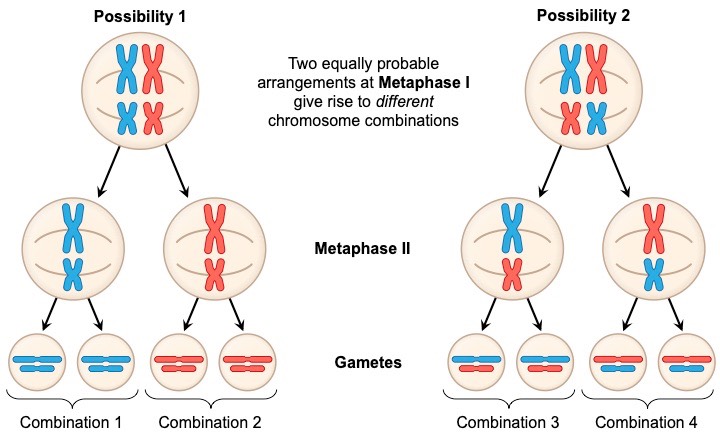Key Knowledge:
|
Meiosis is the process by which sex cells (gametes) are made in the reproductive organs (gonads)
- It involves the reduction division of a diploid germline cell into four genetically distinct haploid nuclei
Overview of Meiosis
The process of meiosis consists of two cellular divisions:
- The first meiotic division separates pairs of homologous chromosomes to halve the chromosome number (diploid → haploid)
- The second meiotic division separates sister chromatids (created by the replication of DNA during interphase)

Stages of Meiosis
Meiosis is preceded by interphase, during which DNA is replicated (in the S phase) to produce two genetically identical copies
- The two identical DNA molecules are identified as sister chromatids, and are held together by a single centromere
Meiosis I
The first meiotic division is a reduction division (diploid → haploid) in which homologous chromosomes are separated
- P-I: Chromosomes condense, nuclear membrane dissolves, homologous chromosomes form bivalents, crossing over occurs
- M-I: Spindle fibres from opposing centrosomes connect to bivalents (at centromeres) and align them along the middle of the cell
- A-I: Spindle fibres contract and split the bivalent, homologous chromosomes move to opposite poles of the cell
- T-I: Chromosomes decondense, nuclear membrane may reform, cell divides (cytokinesis) to form two haploid daughter cells
Meiosis II
The second division separates sister chromatids (these chromatids may not be identical due to crossing over in prophase I)
- P-II: Chromosomes condense, nuclear membrane dissolves, centrosomes move to opposite poles (perpendicular to before)
- M-II: Spindle fibres from opposing centrosomes attach to chromosomes (at centromere) and align them along the cell equator
- A-II: Spindle fibres contract and separate the sister chromatids, chromatids (now called chromosomes) move to opposite poles
- T-II: Chromosomes decondense, nuclear membrane reforms, cells divide (cytokinesis) to form four haploid daughter cells
The final outcome of meiosis is the production of four haploid daughter cells
- These cells may all be genetically distinct if crossing over occurs in prophase I (causes recombination of sister chromatids)
Animation of the Stages of Meiosis
Genetic Variation
The advantage of meiotic division is that it promotes genetic variation in offspring (improving species richness and genetic diversity)
- The main sources of genetic variation arising from meiosis are crossing over (prophase I) and random assortment (metaphase I)
- The random fusion of gametes from different parents (sexual reproduction) will also promote genetic variation in potential offspring
Crossing Over
Crossing over involves the exchange of segments of DNA between homologous chromosomes during prophase I
- The exchange of genetic material occurs between non-sister chromatids at attachment points called chiasmata
As a consequence of this recombination, all four chromatids that comprise the bivalent will be genetically different
- Chromatids that consist of a combination of DNA derived from both homologous chromosomes are called recombinants
- Offspring with recombinant chromosomes will have unique gene combinations that are not present in either parent

Random Assortment
When homologous chromosomes line up in metaphase I, their orientation towards the opposing poles is random
The orientation of each bivalent occurs independently, meaning different combinations of maternal / paternal chromosomes can be inherited when bivalents separate in anaphase I
- The total number of combinations that can occur in gametes is 2n – where n = haploid number of chromosomes
- Humans have 46 chromosomes (n = 23) and thus can produce 8,388,608 different gametes (223) by random orientation
- If crossing over also occurs, the number of different gamete combinations becomes immeasurable
